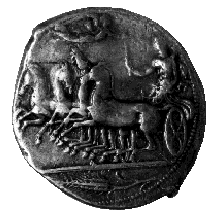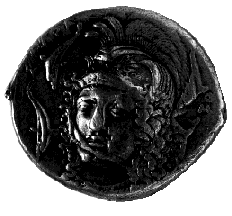



(16) Syracuse, Sicily (Italy) - AR tetradrachm, c. 410 B.C., 17.05
g. (inv. 93.005).
Obverse: Racing quadriga l., Nike flying above horses r.;
in exergue, ear of barley.
Reverse: Facing head of Athena wearing necklace and triple-crested
helmet with raised cheek- pieces; on helmet bowl, ![]() : Eukleidas;
: Eukleidas; ![]() : of the Syracusans.
: of the Syracusans.
Provenance: Harlan Berk, 1992.
Bibliography: L.O. Th. Tudeer, Die tetradrachmenprägung
von Syrakus in der Periode der
signierenden Künstler (Berlin 1913), 59; C.M. Kraay, Archaic
and Classical Greek Coins (Berkeley and Los Angeles 1976).
This coin was signed by one of the great Syracusan die-engravers, Eukleidas;
his abbreviated signature is just legible on the reverse, on the bowl of
Athena's helmet. Like the contemporary head of Arethusa on Kimon's Syracusan
tetradrachm (see no. 17), the head is facing and
surrounded by dolphins, by this time a common feature of Syracusan coins.
The delicacy and detail of Athena's face are somewhat marred by a break
in the die that cuts across her chin.
The depiction of Athena is unusual on Syracusan coins, which typically use
heads of the local nymph Arethusa or of their major deities Demeter and
Persephone, but there was also a temple to Athena in Syracuse, dedicated
after the Syracusans defeated the Carthaginians in the battle of Himera
in 480 B.C. It has been suggested that it was appropriate to recall it at
this time, when Syracuse was once again faced with a Carthaginian invasion,
as one Sicilian city after another fell to her old enemy.
The obverse depicts the racing quadriga that had long been the main type
on Syracusan coins. The spirited horses toss their heads backward and from
side to side, and the fallen marker beneath their hooves gives a sense of
immediacy to the race. The foreshortened wheel of the quadriga also adds
an impression of depth.
C.L.L.



All contents copyright (c) 1996.
Lawrence University
All rights reserved.